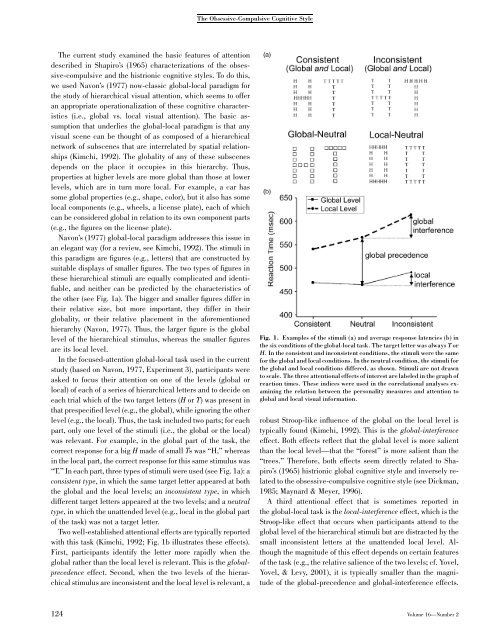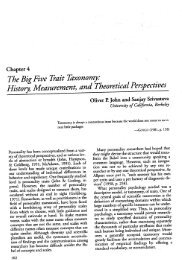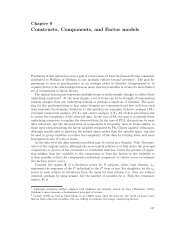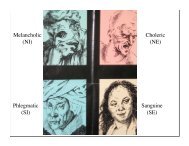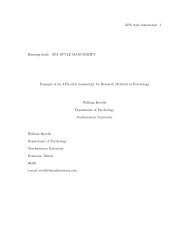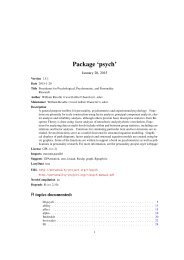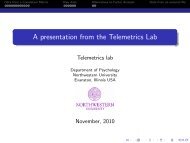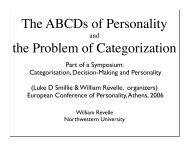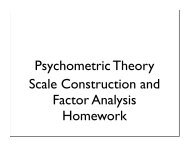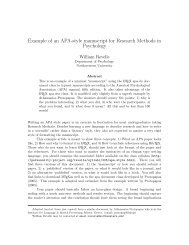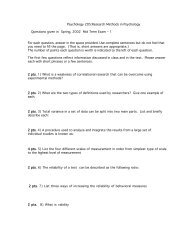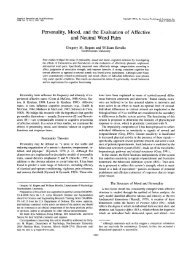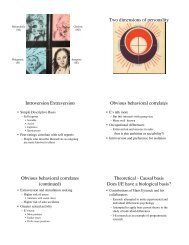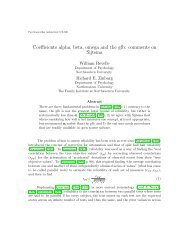<strong>The</strong> Obsessive-Compulsive Cognitive Style<strong>The</strong> current study examined the basic features of attentiondescribed in Shapiro’s (1965) characterizations of the obsessive-compulsiveand the histrionic cognitive styles. To do this,we used Navon’s (1977) now-classic global-local paradigm forthe study of hierarchical visual attention, which seems to offeran appropriate operationalization of these cognitive characteristics(i.e., global vs. local visual attention). <strong>The</strong> basic assumptionthat underlies the global-local paradigm is that anyvisual scene can be thought of as composed of a hierarchicalnetwork of subscenes that are interrelated by spatial relationships(Kimchi, 1992). <strong>The</strong> globality of any of these subscenesdepends on the place it occupies in this hierarchy. Thus,properties at higher levels are more global than those at lowerlevels, which are in turn more local. For example, a car hassome global properties (e.g., shape, color), but it also has somelocal components (e.g., wheels, a license plate), each of whichcan be considered global in relation to its own component parts(e.g., the figures on the license plate).Navon’s (1977) global-local paradigm addresses this issue inan elegant way (for a review, see Kimchi, 1992). <strong>The</strong> stimuli inthis paradigm are figures (e.g., letters) that are constructed bysuitable displays of smaller figures. <strong>The</strong> two types of figures inthese hierarchical stimuli are equally complicated and identifiable,and neither can be predicted by the characteristics ofthe other (see Fig. 1a). <strong>The</strong> bigger and smaller figures differ intheir relative size, but more important, they differ in theirglobality, or their relative placement in the aforementionedhierarchy (Navon, 1977). Thus, the larger figure is the globallevel of the hierarchical stimulus, whereas the smaller figuresare its local level.In the focused-attention global-local task used in the currentstudy (based on Navon, 1977, Experiment 3), participants wereasked to focus their attention on one of the levels (global orlocal) of each of a series of hierarchical letters and to decide oneach trial which of the two target letters (H or T) was present inthat prespecified level (e.g., the global), while ignoring the otherlevel (e.g., the local). Thus, the task included two parts; for eachpart, only one level of the stimuli (i.e., the global or the local)was relevant. For example, in the global part of the task, thecorrect response for a big H made of small Ts was ‘‘H,’’ whereasin the local part, the correct response for this same stimulus was‘‘T.’’ In each part, three types of stimuli were used (see Fig. 1a): aconsistent type, in which the same target letter appeared at boththe global and the local levels; an inconsistent type, in whichdifferent target letters appeared at the two levels; and a neutraltype, in which the unattended level (e.g., local in the global partof the task) was not a target letter.Two well-established attentional effects are typically reportedwith this task (Kimchi, 1992; Fig. 1b illustrates these effects).First, participants identify the letter more rapidly when theglobal rather than the local level is relevant. This is the globalprecedenceeffect. Second, when the two levels of the hierarchicalstimulus are inconsistent and the local level is relevant, aFig. 1. Examples of the stimuli (a) and average response latencies (b) inthe six conditions of the global-local task. <strong>The</strong> target letter was always TorH. In the consistent and inconsistent conditions, the stimuli were the samefor the global and local conditions. In the neutral condition, the stimuli forthe global and local conditions differed, as shown. Stimuli are not drawnto scale. <strong>The</strong> three attentional effects of interest are labeled in the graph ofreaction times. <strong>The</strong>se indices were used in the correlational analyses examiningthe relation between the personality measures and attention toglobal and local visual information.robust Stroop-like influence of the global on the local level istypically found (Kimchi, 1992). This is the global-interferenceeffect. Both effects reflect that the global level is more salientthan the local level—that the ‘‘forest’’ is more salient than the‘‘trees.’’ <strong>The</strong>refore, both effects seem directly related to Shapiro’s(1965) histrionic global cognitive style and inversely relatedto the obsessive-compulsive cognitive style (see Dickman,1985; Maynard & Meyer, 1996).A third attentional effect that is sometimes reported inthe global-local task is the local-interference effect, which is theStroop-like effect that occurs when participants attend to theglobal level of the hierarchical stimuli but are distracted by thesmall inconsistent letters at the unattended local level. Althoughthe magnitude of this effect depends on certain featuresof the task (e.g., the relative salience of the two levels; cf. Yovel,Yovel, & Levy, 2001), it is typically smaller than the magnitudeof the global-precedence and global-interference effects.124 Volume 16—Number 2
Iftah Yovel, William Revelle, and Susan Mineka<strong>The</strong>refore, this effect has rarely been reported in cognitive experiments,which usually study a relatively small number ofparticipants (but see Paquet & Merikle, 1984). Nevertheless,the phenomenon that the local-interference effect measures, theextent to which local small details of stimuli (the trees) interferewith the processing of their global aspect (the forest), seemsdirectly related to Shapiro’s (1965) obsessive-compulsive cognitivestyle.<strong>The</strong> effects observed with the global-local paradigm havebeen previously linked to several personality traits (e.g., Compton& Weissman, 2002; Granholm et al., 2002). For example,Granholm and his colleagues (2002) recently showed thatschizotypal personality disorder is associated with globalprocessing advantage. However, as far as we know, only Dickman(1985) and Maynard and Meyer (1996) specifically examinedShapiro’s (1965) obsessive and histrionic cognitivestyles using this paradigm. Both these studies used speededcard-sorting versions of the focused-attention global-local task,but neither supported Shapiro’s hypotheses. One possible explanationis that the card-sorting version of the global-local taskwas simply not sensitive enough to detect the personality-relatedeffects, and another possibility is that one or both ofShapiro’s hypotheses is incorrect. However, a third possibility isthat both these studies failed to detect the obsessive-compulsivestyle of visual perception because they examined only the morerobust global-precedence and global-interference effects, butnot the local-interference effect, which better operationalizesthis style of visual perception.Why are the global-precedence and global-interference effectsnonideal measures of the obsessive-compulsive style? Onereason is that they are assessed at least in part during the localphase of the task, when participants are being asked to attend tothe local level of the hierarchical stimuli. It is possible that theattention of obsessive individuals is easily drawn to small details,so compared with other people, they identify the smallletters more quickly but also tend to dwell on these details for alonger period of time before responding. Thus, the obsessivecompulsivecognitive style may be associated with both speededand slowed responses to local information that cancel eachother out. This issue becomes irrelevant during the global phaseof the task, when the task is to identify the global big letter.Under these conditions, any process that may result from enhancedattention to the to-be-ignored small letters will increasethe magnitude of interference. Thus, the local-interferenceeffect can be regarded as an unambiguous measure of the detailorientedobsessive-compulsive style of visual attention. Similarly,the global-interference effect, which is measured whenparticipants need to attend to the small local letters and ignorethe big letter, is the clearest operationalization of the globalhistrionic cognitive style. According to this logic, the globalprecedenceeffect, which is based on performance on both theglobal and the local phases of the task, is not the optimalmeasure of either cognitive style. Thus, we predicted that scoreson OCPD-related scales would correlate with the local-interferenceeffect, and that scores on HPD-related scales mightcorrelate with the global-interference effect.<strong>The</strong> personality measures we used were taken from theSchedule for Nonadaptive and Adaptive <strong>Personality</strong> (SNAP;Clark, 1993), which is a self-report inventory designed to assessmaladaptive traits that are relevant to DSM personality disorders.<strong>The</strong> SNAP seemed particularly suitable for the currentcorrelational investigation in a nonclinical population becauseit is based on a dimensional approach that assumes a continuumbetween normal and abnormal personality. <strong>The</strong> reliability andvalidity of the SNAP have been confirmed in both clinical andnonclinical populations (e.g., Clark, 1993; Morey et al., 2003).For example, a recent study that examined the relationshipsbetween the traits measured by the SNAP and the symptomatologyof several personality disorders (including OCPD) in alarge group of patients showed that the SNAP scales were significantlyrelated to structured-interview-based diagnoses ofthese disorders (Morey et al., 2003). Furthermore, these scaleswere able to distinguish patients diagnosed with these disordersfrom several comparison groups, including patients with otherpersonality disorders, depressed patients, and nonclinical individuals.On the basis of these findings, Morey and his colleaguessuggested that individuals with OCPD can be portrayedas perfectionists and workaholics and that HPD is associatedprimarily with exhibitionism.METHODParticipantsParticipants were 89 (56 females) undergraduate students atNorthwestern University who participated in the study as part oftheir research participation requirement. Ten participants wereexcluded from the data analyses because of high error rates(n 5 5) or extreme index scores (n 5 5) in the cognitive tasks(see details in Results). All the analyses were based on theremaining 79 participants.<strong>Personality</strong> Measures<strong>The</strong> SNAP (Clark, 1993; Clark, Vorhies, & McEwen, 2002) is a375-item self-report inventory designed to assess maladaptivetraits that are related to personality disorders in the revisedthird edition of the DSM (DSM-III-R). <strong>The</strong> SNAP includes traitscales and diagnostic scales. Both types of scales show adequatelevels of internal consistency and test-retest reliability inclinical and in nonclinical populations (Clark, 1993; Moreyet al., 2003).<strong>The</strong> SNAP trait scales assess primary trait dimensions relevantto Axis II personality disorders (Clark, 1993; Clark et al.,2002). In this study, five SNAP trait scales relevant to HPD andOCPD were administered (cf. Clark, 1993; Morey et al., 2003):Exhibitionism (relevant to HPD) contains 16 items and taps theVolume 16—Number 2 125


